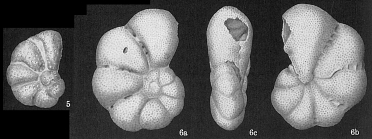WoRMS taxon details
Epistomaroides Uchio, 1952
484691 (urn:lsid:marinespecies.org:taxname:484691)
accepted
Genus
Discorbina turbo var. polystomelloides Parker & Jones, 1865 accepted as Epistomaroides polystomelloides (Parker & Jones, 1865) (type by original designation)
- Species Epistomaroides polystomelloides (Parker & Jones, 1865)
- Species Epistomaroides punctulata (d'Orbigny, 1826)
- Species Epistomaroides yabei (Asano, 1936)
- Species Epistomaroides atlantis (Bermúdez, 1939) accepted as Anomalina atlantis Bermúdez, 1939 (unaccepted > superseded combination, Lacks all the characteristic features of Epistomaroides.)
- Species Epistomaroides coronata (Parker & Jones, 1865) accepted as Discanomalina coronata (Parker & Jones, 1865)
- Species Epistomaroides flintii (Cushman, 1931) accepted as Anomalina flintii Cushman, 1931
- Species Epistomaroides puietaensis (McCulloch, 1977) accepted as Epistomaria puietaensis McCulloch, 1977 (unaccepted > superseded combination, Lacks all the characteristic features of Epistomaroides.)
- Species Epistomaroides pulpitoensis (McCulloch, 1977) accepted as Epistomaria pulpitoensis McCulloch, 1977 (unaccepted > superseded combination, Lacks all the characteristic features of Epistomaroides.)
- Species Epistomaroides punctatus (Said, 1949) accepted as Epistomaroides punctulata (d'Orbigny, 1826)
- Species Epistomaroides rimosa (Parker & Jones, 1862) accepted as Epistomaria rimosa (Parker & Jones in Carpenter, 1862) † accepted as Epistomaria semimarginata (d'Orbigny, 1850) † (Type species of accepted Epistomaria genus)
- Species Epistomaroides semipunctata (Bailey, 1851) accepted as Discanomalina semipunctata (Bailey, 1851)
marine, brackish, fresh, terrestrial
masculine
Uchio, T. (1952). Foraminiferal assemblage from Hachijo Island, Tokyo Prefecture, with descriptions of some new genera and species. <em>Japanese Journal of Geology and Geography.</em> 22:145-159.
page(s): p. 158 [details] Available for editors [request]
[request]
page(s): p. 158 [details] Available for editors
Hayward, B.W.; Le Coze, F.; Vachard, D.; Gross, O. (2024). World Foraminifera Database. Epistomaroides Uchio, 1952. Accessed through: World Register of Marine Species at: https://www.marinespecies.org/aphia.php?p=taxdetails&id=484691 on 2024-11-17
Date
action
by
![]() The webpage text is licensed under a Creative Commons Attribution 4.0 License
The webpage text is licensed under a Creative Commons Attribution 4.0 License
original description
Uchio, T. (1952). Foraminiferal assemblage from Hachijo Island, Tokyo Prefecture, with descriptions of some new genera and species. <em>Japanese Journal of Geology and Geography.</em> 22:145-159.
page(s): p. 158 [details] Available for editors [request]
[request]
additional source Loeblich, A. R.; Tappan, H. (1987). Foraminiferal Genera and their Classification. Van Nostrand Reinhold Company, New York. 970pp., available online at https://books.google.pt/books?id=n_BqCQAAQBAJ [details] Available for editors [request]
[request]
page(s): p. 158 [details] Available for editors
additional source Loeblich, A. R.; Tappan, H. (1987). Foraminiferal Genera and their Classification. Van Nostrand Reinhold Company, New York. 970pp., available online at https://books.google.pt/books?id=n_BqCQAAQBAJ [details] Available for editors
 Present
Present  Inaccurate
Inaccurate  Introduced: alien
Introduced: alien  Containing type locality
Containing type locality
From editor or global species database
Diagnosis Test low trochospiral and biconvex, all chambers of the two whorls visible from the spiral side, only the nine or ten of the final whorl visible on the umbilicate opposite side where supplementary chamberlets formed by a transverse internal partition result in a stellate appearance, sutures deeply incised, bridged by shell material between the multiple sutural openings, periphery rounded, peripheral outline lobulate; wall calcareous, thin, coarsely perforate; primary aperture a low interiomarginal arch extending from the peripheral margin to the umbilicus, small secondary areal opening at the suture between primary and supplementary chambers in the apertural face, and multiple sutural openings present on both sides of the test. Holocene; Pacific Ocean; Indian Ocean; Mediterranean Sea; Red Sea. (Loeblich & Tappan, 1987, Foraminiferal Genera and Their Classification) [details]Unreviewed
Habitat Known from seamounts and knolls [details]


